Embark on a captivating journey through Utah’s diverse birding landscape with our comprehensive guide. This Ultimate Guide highlights the 53 most common birds found throughout the Beehive State, offering detailed insights into their habitats, behaviors, and distinctive characteristics.
Whether you’re a dedicated birder, an outdoor enthusiast, or simply curious about Utah’s unique birdlife, this guide provides a fascinating exploration of the avian wonders that grace this scenic state.
Table of Contents
- 1 Most Common Backyard Birds In Utah
- 1.1 American Robin
- 1.2 House Finch
- 1.3 European Starling
- 1.4 Black-billed Magpie
- 1.5 Common Raven
- 1.6 Dark-eyed Junco
- 1.7 House Sparrow
- 1.8 Mourning Dove
- 1.9 Red-winged Blackbird
- 1.10 Black-capped Chickadee
- 1.11 Northern Flicker
- 1.12 Song Sparrow
- 1.13 Eurasian Collared-Dove
- 1.14 White-crowned Sparrow
- 1.15 Killdeer
- 1.16 Barn Swallow
- 1.17 Lesser Goldfinch
- 1.18 Western Meadowlark
- 1.19 American Goldfinch
- 1.20 Yellow-rumped Warbler
- 1.21 Spotted Towhee
- 2 Frequently Asked Questions
- 2.1 What is the most common bird in Utah?
- 2.2 What is the biggest bird in Utah?
- 2.3 What is the largest owl in Utah?
- 2.4 Where can I see owls in Utah?
- 2.5 Are there golden eagles in Utah?
- 2.6 Does Utah have ravens?
- 2.7 What bird has a yellow belly in Utah?
- 2.8 Are there blue jays in Utah?
- 2.9 Are there roadrunners in Utah?
- 2.10 Are there loons in Utah?
- 2.11 Does Utah have falcons?
- 2.12 Are there osprey in Utah?
- 2.13 Are there cranes in Utah?
- 2.14 Are there magpies in Utah?
- 2.15 What blue birds are in Utah?
- 2.16 Does Utah have peacocks?
- 3 Author
Most Common Backyard Birds In Utah
American Robin

The American Robin is a medium-sized songbird native to North America. This species lives in all parts of the United States, Canada and Mexico, excluding Alaska. It prefers open habitats such as gardens, parks, meadows and farmland, but will also inhabit forests or woodlands with dense undergrowth.
The diet of this bird consists mainly of insects, but it also eats berries from bushes, trees and vines when they are available. In late summer and early fall, many robins head south for their winter migration.
- Frequency: 37.01%
- Color: Mostly brown on the back with an orange colored breast
- Habitat: Wooded areas, backyards, parks, fields
- Range: USA, Canada, Mexico
- Size: 12 – 16″ inches
- Weight: 72 – 95 grams
- Diet: Fruits, berries and insects (earthworms, beetles, caterpillars
- Family: Turdidae
- Genus: Turdus
Related Post:
- Interesting American Robin Fun Facts
- Birds That Look Like Robins But Aren’t
- How to Attract Robins to your yard?
House Finch
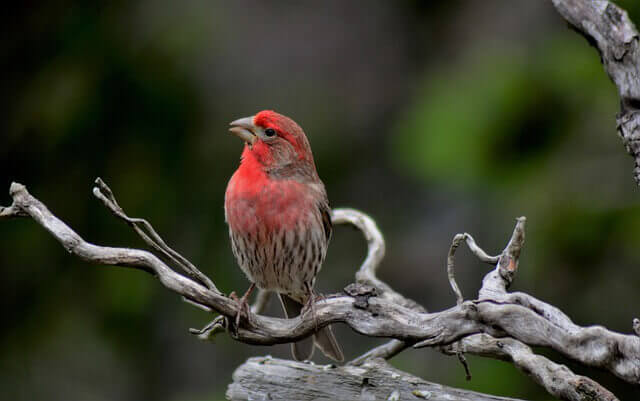
The beautiful house finch is a member of the fuschia finch family, that originates from the eastern part of the United States and was introduced to the western half of the country and even Hawaii. House Finch prefers low branches and trees that are sheltered from the wind, so it is not uncommon to find them in thickets of oak, sycamore, ash, chestnut, or oak-rubble.
They feed on a variety of foods including grasshoppers, crickets, caterpillars, and worms, although they will also eat grapes, apple products, some fruits, and various types of berries. In the wild, these birds usually eat a variety of foods but they have a diet now primarily based on sugary and oily foods.
- Frequency: 31.17%
- Color: Reddish face and upper breast, brown streaks on back, belly, and tail.
- Habitat: urban and suburban areas, backyards, edges, yards, and parks
- Range: Canada, USA, Mexico
- Size: 5 – 6″ inches
- Weight: 16 – 27 grams
- Diet: Aphids, grains, seeds, berries, nettle, dandelion, sunflower
- Family: Fringillidae
- Genus: Haemorhous
Related Post: How to Attract House Finch to your Yard
European Starling
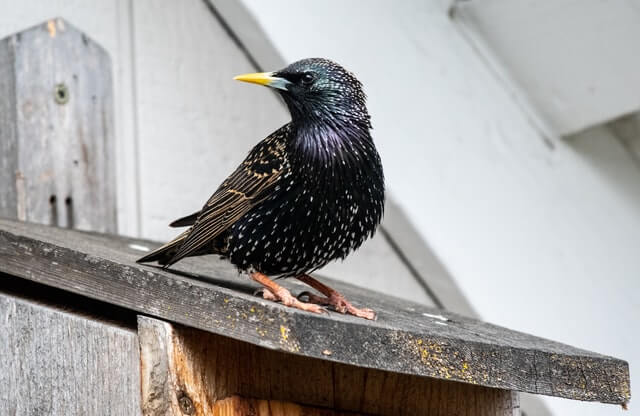
The European Starling is a member of the bird family Sturnidae. They are common in North America and Europe. The starlings inhabit woodlands, forests, wetlands, orchards and agricultural fields.
The diet of a European starling consists mainly of seeds, but also insects such as flies and beetles. They are omnivores with a diverse diet consisting mostly of plant matter, but they also consume small animals including insects which they will catch on the ground. They migrate southward each year for the winter months, and return north in the spring.
- Frequency: 30.44%
- Color: Black with glossy iridescence plumage
- Habitat: Forests, woodlands, backyards, edges, yards, and parks
- Range: North America, Europe, Africa, India, Middle East, China
- Size: 7 – 9″ inches long
- Weight: 60 – 100 grams
- Diet: Insects (ants, beetles, invertebrates), fruits, seeds, berries
- Family: Sturnidae
- Genus: Sturnus
Related Post:
Black-billed Magpie
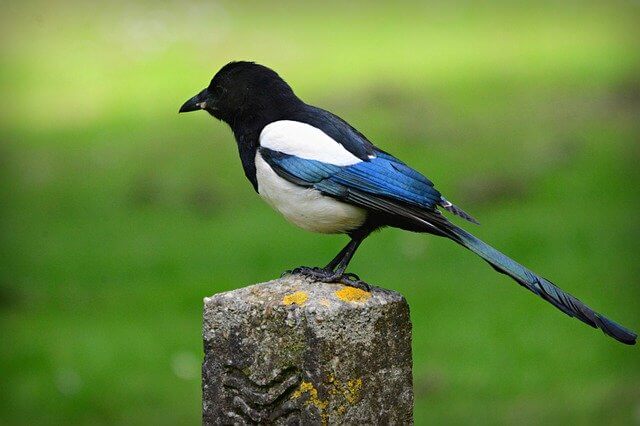
This beautiful bird lives in clusters in fields and along the edges of roads, but it is not uncommon to find one in a birdhouse or any other structure where food and water are abundant. When it is not active, the Black-billed magpie will spend at least two hours each day roosting on the branch above its perch.
During the day it flits about in search of food such as moths, beetles, grasshoppers, gnats, snakes, and even birds and mammals. During the winter, these birds tend to stay inside their birdhouses, but in the spring they venture out into grasslands and open fields.
- Frequency: 28.84%
- Color: Black and white and has a black bill. In good light, black on wings and tail is iridescent blue, violet, green.
- Habitat: Farmlands, backyards and suburban areas,
- Range: Western part of North America, from Colorado, Utah, Alaska, Oregon, California, Nevada, Arizona, New Mexico, Kansas, Nebraska
- Size: 18 – 24″ inches long
- Weight: 140 – 215 grams
- Diet: insects, carrion, seeds, rodents, berries, nuts, eggs
- Family: Corvidae
- Genus: Pica
Common Raven
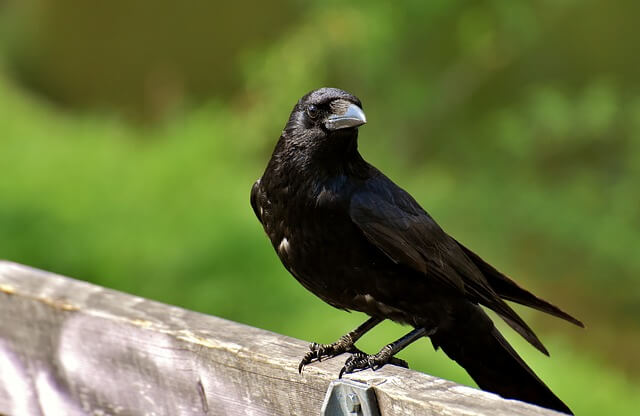
The Common Raven is a large, all black passerine bird, with an average size of about twenty-five inches. It is by far the most widespread of all passerines, present in a wide variety of areas across the Northern Hemisphere. It has a long and massive neck and impressive black body.
It is rather active throughout the year, although during winter it prefers to forage on the ground and dig through the snow. In the spring and summer it preys upon carrion, berries, insects, fruit, small animals, nesting birds, and garbage in its territory.
- Frequency: 26.91%
- Color: All black iridescent plumage
- Habitat: Wooded areas, evergreen forests, tundra, roadside, grasslands, backyards, parks
- Range: Found throughout the Northern Hemisphere
- Size: 21 – 26 inches long
- Weight: 1.5 – 4.5 lbs.
- Diet: Mainly scavengers, feeding on carrion, beetles, and maggots.
- Family: Corvidae
- Genus: Corvus
Related Post: 18 Fun Facts About Ravens
Dark-eyed Junco
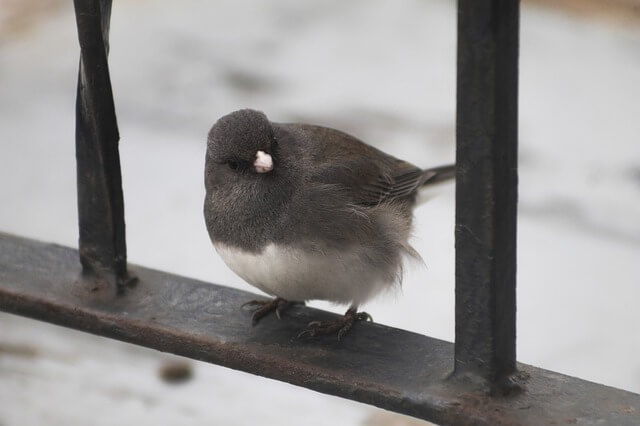
The dark-eyed junco, variable species of the genus Junco, which is native to North America. It is common throughout much of western North America, south through central Mexico and into the high arctic. The dark-eyed junco has seen a rapid increase in numbers across the United States in the past decade.
They are especially common in snowy areas between late December and early January in the south. They may also be present in parts of Arizona, Colorado, New Mexico, Texas, Oklahoma, Illinois, Maryland, and even Ontario.
- Frequency: 24.67%
- Color: Gray head, neck, breast, gray/brown backs and wings, white underside
- Habitat: Wooded areas, forest edges, roadsides, gardens, parks.
- Range: USA and Canada
- Size: 5.1 – 6.9″ inches
- Weight: 18 – 30 grams
- Diet: Seeds, insects, and arthropods
- Family: Passeriformes
- Genus: Junco
Related Post:
House Sparrow
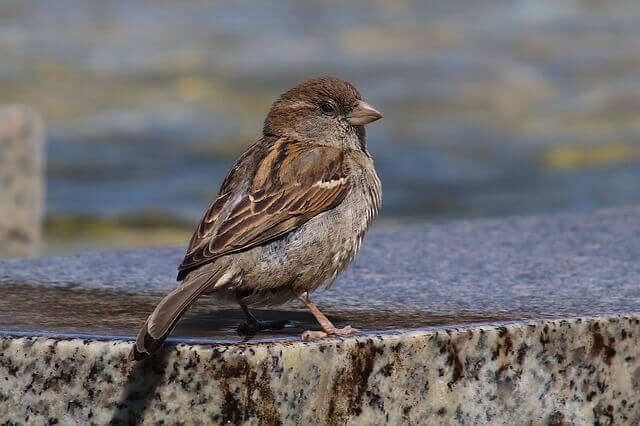
The house sparrow is a small bird that is native to Europe and North Africa. It has also been introduced in many other countries such as the United States of America, Canada, Mexico and Argentina. They are considered pests because they live in proximity to humans. The diet of this bird includes insects like flies, moths and beetles; seeds from weeds or cereal crops; grains from kitchen scraps; pet food left outside.
In the winter months, house sparrows migrate south for warmer climates, where food can be more readily found. House sparrows nest in cavity walls, trees, short runways, masonry units, roof eaves, and under decks and porches. Housed birds generally roost together in large groups of two to ten, but some can be found alone or in pairs beneath deciduous trees.
- Frequency: 22.09%
- Color: Gray head marking, a reddish-brown back, and gray underparts
- Habitat: Urban centers, suburban areas, backyards, edges, yards, and parks
- Range: North America, Central America, South America, Africa, Australia, New Zealand
- Size: 5.5 – 7.1″ inches in length
- Weight: 25 – 39 grams
- Diet: Insects, beetles, caterpillars, aphids,, grasshoppers, crustaceans, earthworms, vertebrates
- Family: Passeridea
- Genus: Passer
Related Post: How to Attract Sparrows to your Backyard
Mourning Dove
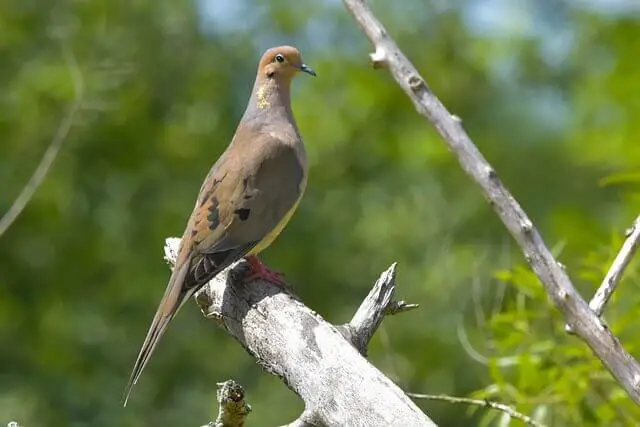
The Mourning Dove is a small, medium-sized bird. They are one of the most common birds in North America and inhabit much of the eastern United States, southern Canada, Central America and northern South America. They are found in every region of the United States, and they can be seen on lawns and fields during spring and summer.
The diet of the mourning dove consists mainly of seeds from grasses, grains, fruits, acorns or insects that it finds on the ground. Their habitat ranges from semi-arid areas to tropical forests, as well as open country with scattered trees or large patches of shrubs. Mourning Doves will migrate south during the winter months.
- Frequency: 21.92%
- Color: Light gray-brown and lighter and pinkish below. The wings have black spots.
- Habitat: Open habitats, urban areas, farms, prairie, grassland, wooded area
- Range: USA, Canada, Mexico, Central America, Greater Antilles
- Size: 12″ inches length
- Weight: 112 – 170 grams
- Diet: Rapeseed, corn, millet, safflower, sunflower seeds, pokeberry, sesame, and wheat.
- Family: Columbidae
- Genus: Zenaida
Related Post: Facts About Mourning Doves
Red-winged Blackbird

The red-winged blackbird is a common sight across North America. It’s been seen in many locations, including the US and Canada. The bird has a wide range of habitats it can inhabit and diet that varies depending on where it lives. In some areas, the birds migrate to warmer climates during winter months while others stay put year round.
Their habitat ranges from open habitats like marshes and prairies to wetland forests with trees. They are omnivores who feed on seeds, insects, worms and amphibians as well as small mammals or birds when available.
- Frequency: 21.34%
- Color: All black with red patches on shoulder and a yellow wing bars.
- Habitat: Deciduous forests, conifers, roadside, rivers, backyards, parks
- Range: North America, Central America
- Size: 6.7 – 7.1″ inches length
- Weight: 41.5 – 65 grams
- Diet: Seeds and insects (butterflies, dragonflies, moths, frogs, worms, spiders, snails, carrion, flies.)
- Family: Icteridae
- Genus: Agelaius
Black-capped Chickadee
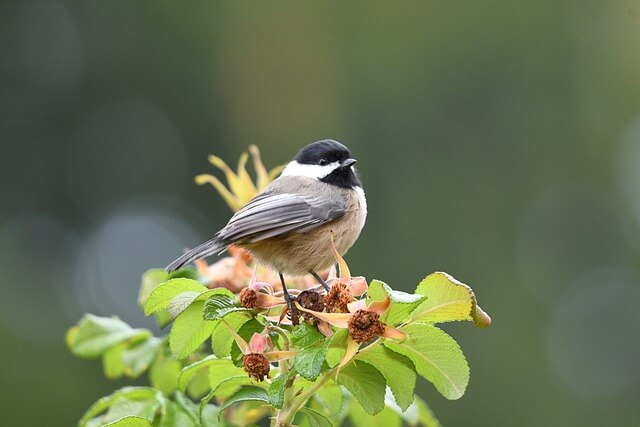
The Black-capped Chickadees range covers a wide territory, including the United States and Canada. They are generally found in habitats of mixed forests, forest edges, scrubby areas with trees and understory vegetation as well as around parks and gardens.
The Black-capped Chickadees diet includes insects, seeds, berries and other fruit which they eat both on the ground or from tree branches. This species spends its winters in Central America and as far south as Mexico if food sources are low.
- Frequency: 20.97%
- Color: Black-cap, white on face, white/reddish-brown flanks
- Habitat: Deciduous and mixed forests, backyards, parks
- Range: USA and Canada
- Size: 11.5 -16 cm length
- Weight: 8 – 15 grams
- Diet: Insects, seeds, berries
- Family: Paridae
- Genus: Poecile
Related Post: How Do I Attract Chickadees To My Yard?
Northern Flicker
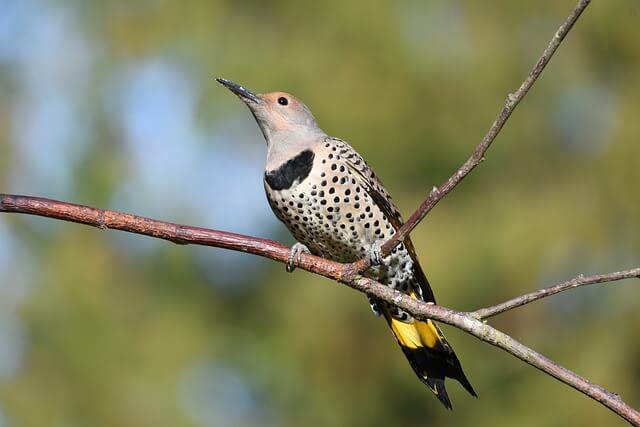
Northern Flicker is a beautiful bird that can be found almost anywhere in the United States and Canada. These birds were highly valued during the colonial days because of their beauty, which was said to be more beautiful than any other species in the U.S. Northern Flickers are particularly nice year round. However, you might notice a different kind of behavior during the fall, winter and spring, as they prepare for the flight back south.
This is an amazing bird because of its brilliant colors and lovely chirping sounds that seem so peaceful. They will often come out of their hiding places to the open air and make strange calls to attract other birds and you can recognize them by the soft squawking of their throats. Flickers are also very playful and will often climb trees and look for insects.
- Frequency: 20.79%
- Color: Brown with black bars on the back and wings
- Habitat: Open habitats near trees, including woodlands, edges, yards, and parks
- Range: North America, parts of Central America, Cuba, and the Cayman Islands,
- Size: 11 – 14″ length
- Weight: 86 – 167 grams
- Diet: Insects, seeds, berries
- Family: Picidae
- Genus: Colaptes
Related Post: How to Attract Northern Flickers to your yard?
Song Sparrow

The song sparrow fly easily in flocks and prefer to nest in areas with high amounts of cover where there is enough food to survive. During spring and fall, these birds are very active, with adults and offspring singing for hours on end. They are not generally aggressive, although they may display some display during courtship and when seeking partners. This small bird lives in the coastal regions of Southern California and Eastern Oregon.
With habitats ranging from coastal grasslands to rocky cliffs and rocky plateaus, Song Sparrow is able to do well in most kinds of habitats. They prefer open areas with access to water, nooks and crannies, where they feed by picking at the leaves of brushy plants, leaf litter, and weeds. However, they also take refuge in parks and other conservation areas, swamps, and tall grasslands.
- Frequency: 20.35%
- Color: Gray head, white cheek, a black bib, rufous neck
- Habitat: Urban centers, farms, backyards, edges, yards, and parks
- Range: Europe, Mediterranean, Asia, Australasia, Africa, and the Americas
- Size: 5.5 – 7.0″ inches
- Weight: 25 – 40 grams
- Diet: Grains, seeds, and insects
- Family: Passeridea
- Genus: Passer
Related Post: How to Attract Sparrows to your Backyard
Eurasian Collared-Dove
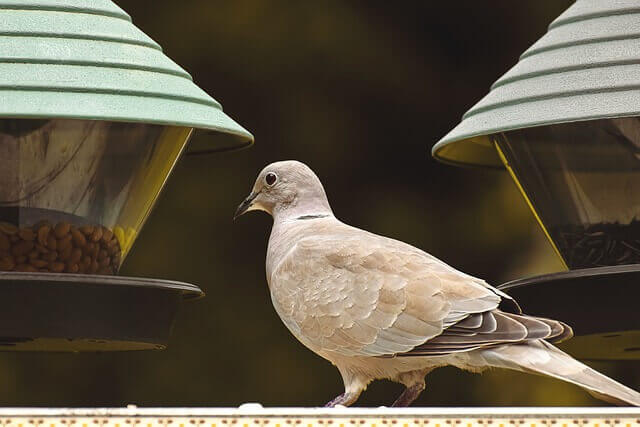
The Eurasian-collared Dove is a native species to the Americas. It’s range stretches from southern Texas all the way up to northern Argentina, as well as Central America and Colombia. They typically live in arid regions of scrubby brushlands or deserts with some trees or scattered shrubs. They are usually found near streams, waterholes, canals, wells and irrigation ditches where they can find seeds for food such as wheat or corn.
This species eats mainly seeds and grains, sometimes eating small insects or earthworms too. In winter months they migrate to more temperate regions where they feed on the crops. It is the only dove species that migrates south for winter.
- Frequency: 20.32%
- Color: Pinkish-gray with ablack half-collar bar with white on its neck
- Habitat: Urban centres, farms, backyards, edges, yards, and parks
- Range: North America, Central America, South America, Europe, Asia
- Size: 13″ inches
- Weight: 150 grams
- Diet: Millet, milo, sunflower, wheat, corn and berries
- Family: Columbidae
- Genus: Streptopelia
White-crowned Sparrow
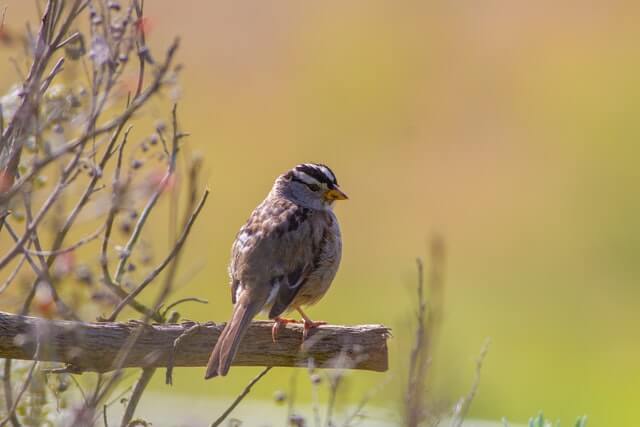
The white-crowned Sparrow is a common species of passerine bird indigenous to North America. Visitors to the gardens of the the greater Utah area, which is the location of the main wintering areas for the white-crowned sparrows. They typically come back every year and breed in the fall and wintertime as they prepare for the coming winter.
They will nest in dry, decaying wood or anywhere else with a bit of water or where there are food and cover. They also take food back to the nest often during the summer, as part of their survival instincts. The female White-crowned Sparrow will nest in a cavity where there is an abundant supply of dry wood, stems, leaves, and other debris.
- Frequency: 15.53%
- Color: Black and white stripes on their head, gray face, brown-streaked upper, and a long tail. Brown wings with bars and the underparts are gray.
- Habitat: Brushy areas
- Range: Western USA, and Northern Canada
- Size: 5.9″ – 6.3″ inches long
- Weight: 25 – 28 grams
- Diet: Seeds, insects, and plants
- Family: Passerellidae
- Genus: Zonotrichia
Killdeer
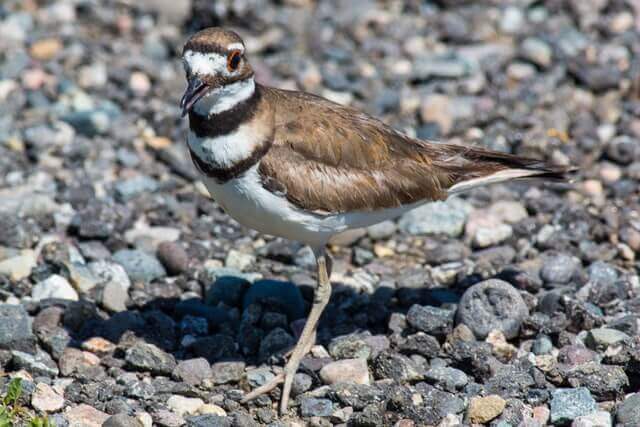
The Killdeer is a bird in the Charadriidae family, which also includes other birds such as plovers and sandpipers. The Killdeer can be found throughout North America, with its range extending from Canada to South America. They have short, thick bills for feeding on insects and crustaceans they find in mud or water. They are ground-feeders, so they spend most of the time foraging on the ground.
The habitat they live in varies by season, but typically their habitats are prairies or other grasslands near water sources such as lakes, rivers or wetlands. They usually feed on insects and earthworms during the summer months, and will switch to mostly seeds when it starts to get colder out. In spring, they begin their migration to their breeding grounds, which are usually far north.
- Frequency: 14.52%
- Color: Brown-tan on upper body and white underneath. The white chest has two black bands, brown face with black and white patches.
- Habitat: Beach habitats and coastal wetlands and fields
- Range: USA, Southern Canada, and Mexico
- Size: 7.9 – 11″ inches long
- Weight: 72 – 120 grams
- Diet: Millipedes, worms, snails, spiders, and some seeds
- Family: Charadriidae
- Genus: Charadrius
Barn Swallow

The barn swallow is by far the most common species of swallow in the United States. It is a unique blue-winged passerine swallow with a white underside, and a black, pointed trailing tail. It is commonly found in North America, Europe, Asia, and Africa. Barn Swallows are common in wooded areas near coasts, near estuaries and other areas of water bodies.
They often visit shorelines and fly slowly over weedbeds and cliff faces, using these landing sites to seek out food, nectar, and females for mating. In addition to their foraging habits, Barn Swallows are social birds that spend a great deal of time together. They live in flocks, fly in flocks, and fly circles. In both nature and captivity, Barn Swallows is extremely social, noisy birds.
- Frequency: 13.99%
- Color: Blue upper and a reddish-brown forehead, throat and chin, whitish-gray underparts and a blue band on breast.
- Habitat: Open country, pastures, meadows, parks, backyards and fields
- Range: Canada, United States, Central and South America
- Size: 6.5″ – 7.5″ inches long
- Weight: 16 – 22 grams
- Diet: Berries, seeds, insects
- Family: Hirundinidae
- Genus: Hirundo
Lesser Goldfinch
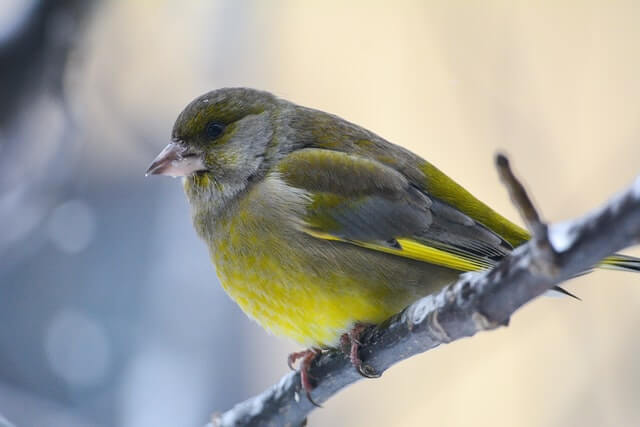
Lesser goldfinch are commonly seen in parks, backyards, in abandoned buildings, bird feeders and in wet areas surrounding water. They also are found in residential backyards along the fence lines, in abandoned birdhouses, feeder boxes, along river banks, along the roadside fences, and even in our gardens.
Lesser goldfinches are common in urban areas but are less common than other species in natural bird populations. Lesser goldfinch also form small flocks in wooded areas; these small flocks give rise to a beautiful, unique type of bird life in metropolitan areas, as the bird’s nest near the nesting site.
- Frequency: 13.94%
- Color: Bright yellow underparts, white patches on the tail and wings
- Habitat: Almost any habitat with trees or shrubs, backyards
- Range: Southwestern United States, Washington, Peru, Venezuela
- Size: 3.5 – 4.7″ inches long
- Weight: 8 – 12 grams
- Diet: Tree buds and weed seeds
- Family: Fringillidae
- Genus: Spinus
Western Meadowlark
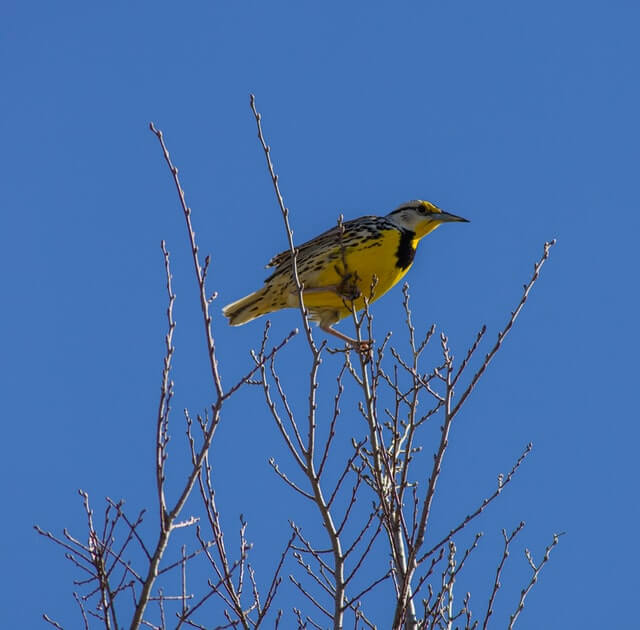
The western meadowlark is an uncommon large interim flying bird found only in the eastern United States. The meadowlarks preferred to nest near creeks and rivers since they prefer to eat fish and other birds. It is a fast flycatcher which has been observed frequently beneath overhanging ledges and trees in wetland areas.
The western meadowlark, is a medium-sized icterid bird . It nests largely on the ground at mid to higher elevations in open areas across central and western North America. It feeds mainly on berries and seeds but will also eat insects. It is a frequent visitor to open meadows and bird feeders.
- Frequency: 13.35%
- Color: Mostly brown upper with black streaks and yellow underparts
- Habitat: Pastures, prairies, grasslands, and fields,
- Range: Western and central North America
- Size: 8.5″ inches in length
- Weight: 90 – 115 grams
- Diet: Bugs, seeds, berries
- Family: Icteridae
- Genus: Sturnella
American Goldfinch

The American Goldfinches are common in North America and the Eastern part of Canada. They have a range that covers from Alaska to Florida, and eastward through Central America. The Goldfinches’ habitat is typically open woodland, orchards, parks, deciduous forests, shrubby areas, parks and residential gardens.
American Goldfinch diet consists mainly of seeds, but they also eat fruit, insects, weed seeds and some leaf buds. They usually migrate south for the winter months, but some stay behind due to changes in climate or habitat.
- Frequency: 12.65%
- Color: Face, neck, and underside are yellow, black wings with white bars
- Habitat: Deciduous forests and thickets, roadside, grasslands, backyards, meadows
- Range: Canada, USA and Mexico
- Size: 4.3 – 5.5″ inches length
- Weight: 12 -18 grams
- Diet: Grass, dandelions, chickweed, sunflowers and ragweed, thistle, red alder, birch, spruce seeds
- Family: Carduelinae
- Genus: Spinus
Related Post: American Goldfinch Interesting Facts
Yellow-rumped Warbler
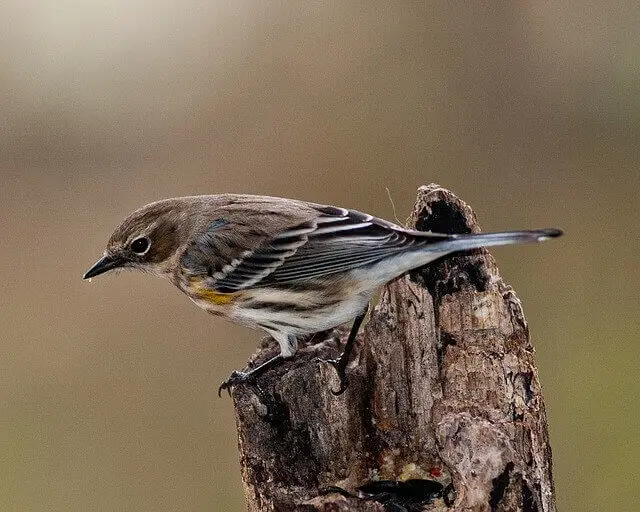
The Yellow-rumped Warbird is ordinary North American bird species that can be found all across the continental United States. This bird is mostly seen in forested areas around the United States in the southern states of Utah, Texas, Oklahoma, and New Mexico and also in the northern parts of Colorado.
The winter range for this bird is generally from mid to late spring to early summer. During the winter period the yellow-rumped warbler migrates to the southern states of North America and winters are generally short in the northern states. In the central states of central America the birds migrate into the southern states around the end of summer.
The Yellow-rump warbler has a highly diverse habitat across its three migratory ranges. In the southern states they tend to be found in deserts and wooded areas with rocky soil and brush. There they concentrate around nesting places such as junctures, cliffs, brush, stumps and undergrowth. In the north they generally find open meadows, cliffs, brush, and low-lying areas in forests.
- Frequency: 12.59%
- Color: Yellow patches on the crown, flanks, rump & blackish-blue streaks on the back, breast, and wings
- Habitat: Deciduous forests and thickets, roadside, grasslands, backyards
- Range: U.SA, Canada, Mexico, Central America, and the Caribbean
- Size: 4.7 – 5.9″ inches long
- Weight: 10 – 18 grams
- Diet: grasshoppers, gnats, aphids, caterpillars, wasps, beetles, spiders, berries,
- Family: Parulidae
- Genus: Setophaga
Spotted Towhee
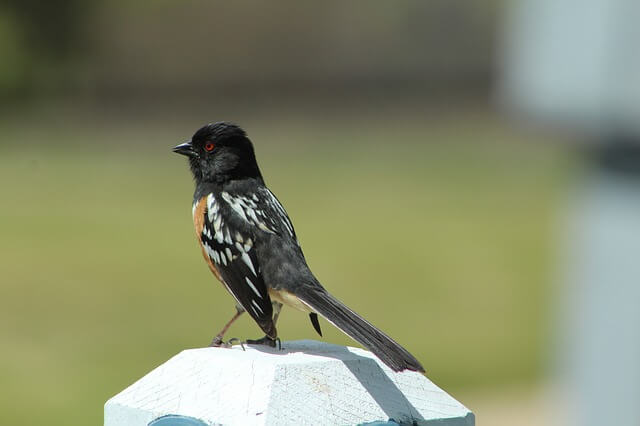
The Spotted Towhee is a small, ground-dwelling bird that lives in shrubby areas of eastern North America. They can be found from southern Canada to the Gulf Coast. The Spotted Towhee’s range includes most of the Eastern United States, as well as parts of Mexico and Central America. The towhees inhabit deciduous and mixed forests in both rural and urban areas, but are more commonly found near open woodlands or hedgerows with scattered trees or shrubs.
They eat mostly insects, berries and seeds during the summer months and then switch to primarily nuts, seeds and fruits when food becomes scarce during winter months. In late fall they migrate southward for the winter until returning north again.
- Frequency: 12.28%
- Color: Dark head, upper body, tail and a white belly, white spots on the back, white wing bars, rufous sides
- Habitat: Wooded areas, forest edges, roadsides, gardens, parks.
- Range: USA and Canada
- Size: 6.7 – 8.3″ inches
- Weight: 33 – 49 grams
- Diet: Spiders, insects, and arthropods
- Family: Passerellidae
- Genus: Pipilo
The backyard birds below have a frequency of less than 12%
- Woodhouse’s Scrub-Jay – (12% Frequency)
- Yellow Warbler – 10.70%
- Western Kingbird – 9.30%
- Black-chinned Hummingbird – 9.02%
- Ruby-crowned Kinglet – 8.62%
- Rock Pigeon – 8.49%
- Pine Siskin – 8.42%
- American Avocet – 8.24%
- Downy Woodpecker – 8.16%
- Yellow-headed Blackbird – 7.97%
- Brewer’s Blackbird – 7.80%
- California Quail – 7.54%
- Mountain Chickadee – 7.15%
- American Crow – 7.11%
- Ring-necked Pheasant – 7.08%
- Cliff Swallow – 6.71%
- Chipping Sparrow – 6.67%
- White-faced Ibis – 6.60%
- Broad-tailed Hummingbird – 6.27%
- Black-headed Grosbeak – 6.09%
- Red-breasted Nuthatch – 5.99%
- Brown-headed Cowbird – 5.92%
- Tree Swallow – 5.89%
- Lazuli Bunting – 5.82%
- Say’s Phoebe – 5.77%
- Violet-green Swallow – 5.76%
- Bullock’s Oriole – 5.70%
- Western Tanager – 5.67%
- Common Goldeneye – 5.46%
- Northern Rough-winged Swallow – 5.40%
- Blue-gray Gnatcatcher – 5.19%
- Marsh Wren – 5.12%
Frequently Asked Questions
What is the most common bird in Utah?
Utah is home to many birds, but the most common bird in Utah is the American Robin. This species accounts for 47% of all observed birds in the state and can be found year-round.
What is the biggest bird in Utah?
The California Condor is the biggest bird in Utah. It can grow up to 4.5 feet in length, and weigh up to 22 pounds, with a wingspan of 8-10 feet, which makes it one of the largest birds in North America. Condors have a beak that measures about 2 inches across at its widest point, making it able to rip open carcasses with ease.
What is the largest owl in Utah?
The largest owl in Utah is the Great-Horned Owl. They are two feet in length, with a wingspan of about five feet, and can weigh up to five and a half pounds. These owls are usually found in forested areas, especially near cliffs or caves that provide them with good nesting sites.
Where can I see owls in Utah?
If you live in Utah, there is a good chance that you will see one at some point. The list below includes the best places to see owls in Utah: 1) The Great Salt Lake Desert, for barn and screech owls. 2) Rocky Mountain Forest State Park, for great horned owls. 3) Powder Mountain Ski Resort, near Eden Valley Reservoir, for snowy owl sightings.
Are there golden eagles in Utah?
It turns out that there are Golden Eagles in Utah, but they are fairly uncommon, with a frequency of just 4%. They have been spotted mainly around the mountainous areas. One sighting was on Red Butte Mountain and another near the Henry Mountains. There is one known nesting site near Mountain Green.
Does Utah have ravens?
Yes, Utah does have ravens. The Common Raven is the largest member of the crow family in North America and is one of the most widely distributed birds in the world. Ravens are found in nearly all habitats, including deserts, forests, mountains, and tundra. In Utah, Common Ravens can be found in many different habitats including Great Basin Desert, Rocky Mountains, and Colorado Plateau.
What bird has a yellow belly in Utah?
The Yellow-rumped Warbler and the Common Yellowthroat are both small birds with yellow bellies that can be found in Utah. The Yellow-rumped Warbler is a fairly common sight in the state, while the Common Yellowthroat is less often seen but can still be found in some areas. Both of these birds are interesting creatures, and it is fun to watch for them when out on a nature walk or hike.
Are there blue jays in Utah?
There are blue jays in Utah, but they aren’t as common as they are in other parts of the country. According to the Cornell Lab of Ornithology, the blue jay has a 4.5 percent frequency of occurrence in Utah. That means that if you see 100 birds in Utah, only four or five of them will be blue jays.
Are there roadrunners in Utah?
Yes, there are roadrunners in Utah. The Greater Roadrunner is found in the southwestern United States, including Utah. However, it is important to note that roadrunners are more commonly found in the southern regions of the state, where the climate is warmer and drier.
Are there loons in Utah?
There are four species of loons that have been recorded in Utah: the common loon, Pacific loon, yellow-billed loon, and red-throated loon. The most frequently seen species is the common loon. Pacific loons are the second most frequently seen species in Utah, and they are more likely to be seen in the western part of the state. Yellow-billed and red-throated loons are less frequently seen, but they have both been recorded in Utah.
Does Utah have falcons?
There are three species of falcons that can be found in Utah: the prairie falcon, the peregrine falcon, and the gyrfalcon. The prairie falcon is the most common of the three, and can be found in open areas throughout the state. The peregrine falcon is less common, but can still be found in some areas, particularly near cliffs or other high places. The gyrfalcon is the rarest of the three, and is only found in a few isolated locations.
Are there osprey in Utah?
Osprey are a type of raptor that can be found in many parts of the world, including Utah. In Utah, the frequency of occurrence for Osprey is about 7.5 percent. This means that you have a good chance of seeing one if you go to the right place at the right time.
Are there cranes in Utah?
There are two species of crane that have been spotted in Utah: the sandhill crane and the whooping crane. The sandhill crane is the most common, and the whooping crane is much rarer. The sandhill crane is typically found in open grasslands or wetlands, while the whooping crane prefers wooded areas near bodies of water.
Are there magpies in Utah?
There are black-billed magpies in Utah. In fact, it’s the second most common bird in the state. The magpie is a member of the corvid family, which also includes crows and ravens. Magpies are known for their intelligence and their ability to solve complex problems.
What blue birds are in Utah?
There are ten different types of blue birds that can be found in Utah: the pinyon jay, mountain bluebird, blue jay, western bluebird, barn swallow, eastern bluebird, blue-gray gnatcatcher, blue grosbeak, belted kingfisher and lazuli bunting.
Does Utah have peacocks?
Utah is home to many different animals, but peacocks are not one of them. While these colorful birds are native to India and Sri Lanka, they can be found in zoos and private residences around the world. Peacocks are not well-suited to cold weather, so they would not be able to survive in Utah’s climate.


